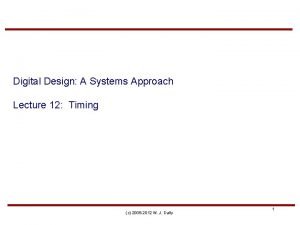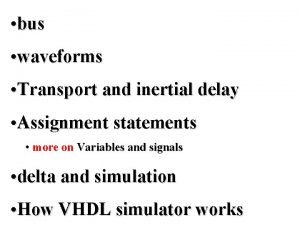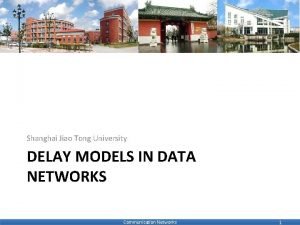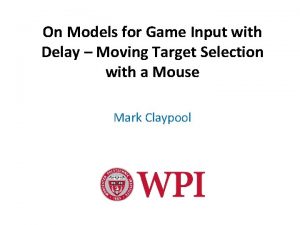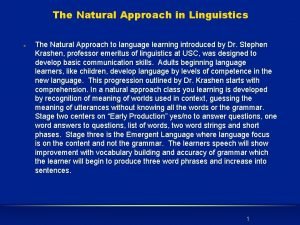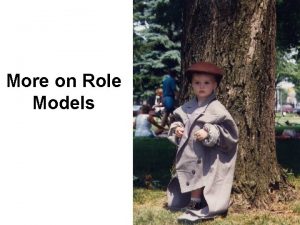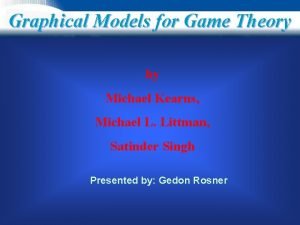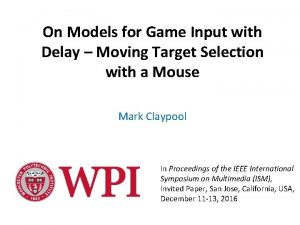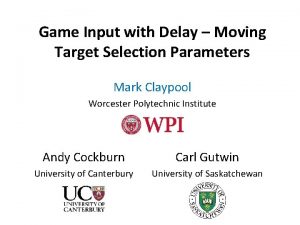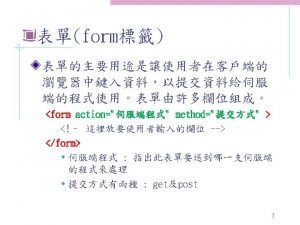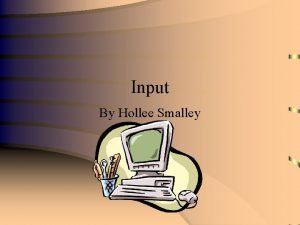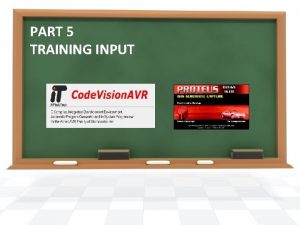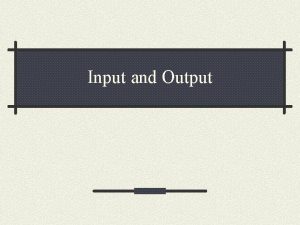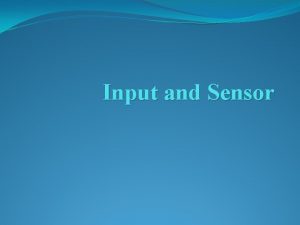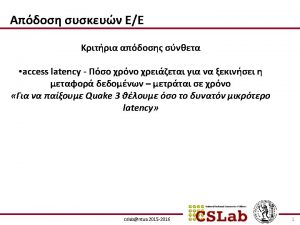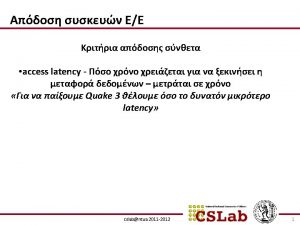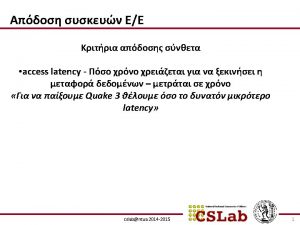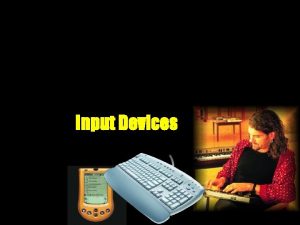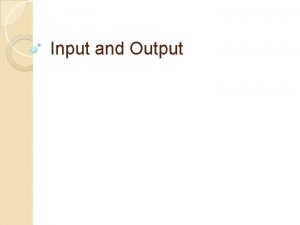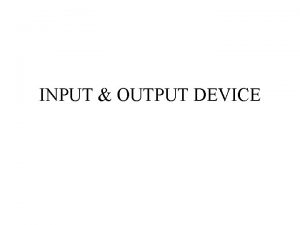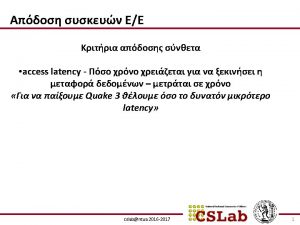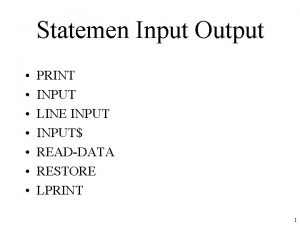On Models for Game Input with Delay Moving

![Introduction • Real-time games sensitive to delay [Claypool, 2006] – Even 10 s of Introduction • Real-time games sensitive to delay [Claypool, 2006] – Even 10 s of](https://slidetodoc.com/presentation_image_h/90d00752a6d9c85bcfd935c2962ca1a5/image-2.jpg)
![Introduction • Real-time games sensitive to delay [Claypool, 2006] – Even 10 s of Introduction • Real-time games sensitive to delay [Claypool, 2006] – Even 10 s of](https://slidetodoc.com/presentation_image_h/90d00752a6d9c85bcfd935c2962ca1a5/image-3.jpg)
![Introduction • Real-time games sensitive to delay [Claypool, 2006] – Even 10 s of Introduction • Real-time games sensitive to delay [Claypool, 2006] – Even 10 s of](https://slidetodoc.com/presentation_image_h/90d00752a6d9c85bcfd935c2962ca1a5/image-4.jpg)

![Research in Games and Delay Game Genres [Armitage, 2003] UT Warcraft Ever. Quest [Chen, Research in Games and Delay Game Genres [Armitage, 2003] UT Warcraft Ever. Quest [Chen,](https://slidetodoc.com/presentation_image_h/90d00752a6d9c85bcfd935c2962ca1a5/image-6.jpg)
![Research in Games and Delay Game Genres Quake [Hajri, 2011] [Mac. Kenzie, 1992] [Hoffman, Research in Games and Delay Game Genres Quake [Hajri, 2011] [Mac. Kenzie, 1992] [Hoffman,](https://slidetodoc.com/presentation_image_h/90d00752a6d9c85bcfd935c2962ca1a5/image-7.jpg)
![Research in Games and Delay Game Genres Quake [Hajri, 2011] [Mac. Kenzie, 1992] [Hoffman, Research in Games and Delay Game Genres Quake [Hajri, 2011] [Mac. Kenzie, 1992] [Hoffman,](https://slidetodoc.com/presentation_image_h/90d00752a6d9c85bcfd935c2962ca1a5/image-8.jpg)
![Fitts’ Law [Fitts, 1954] Time to select target http: //www. yorku. ca/mack/hci 1992 -f Fitts’ Law [Fitts, 1954] Time to select target http: //www. yorku. ca/mack/hci 1992 -f](https://slidetodoc.com/presentation_image_h/90d00752a6d9c85bcfd935c2962ca1a5/image-9.jpg)
![Fitts’ Law [Fitts, 1954] Time to select target 10 Fitts’ Law [Fitts, 1954] Time to select target 10](https://slidetodoc.com/presentation_image_h/90d00752a6d9c85bcfd935c2962ca1a5/image-10.jpg)
![Fitts’ Law [Fitts, 1954] Gap distance Width Time to select target Constant (determined empirically) Fitts’ Law [Fitts, 1954] Gap distance Width Time to select target Constant (determined empirically)](https://slidetodoc.com/presentation_image_h/90d00752a6d9c85bcfd935c2962ca1a5/image-11.jpg)
![Fitts’ Law [Fitts, 1954] Gap distance Width Time to select target Constant (determined empirically) Fitts’ Law [Fitts, 1954] Gap distance Width Time to select target Constant (determined empirically)](https://slidetodoc.com/presentation_image_h/90d00752a6d9c85bcfd935c2962ca1a5/image-12.jpg)
![Limitations of Fitts’ Law • One dimension 2 dimensions [Mac. Kenzie, 1992] • Stationary Limitations of Fitts’ Law • One dimension 2 dimensions [Mac. Kenzie, 1992] • Stationary](https://slidetodoc.com/presentation_image_h/90d00752a6d9c85bcfd935c2962ca1a5/image-13.jpg)
![Why Moving Target Selection with Mouse? [Call of Duty, Activision, 2003] [Duck Hunt, Nintendo, Why Moving Target Selection with Mouse? [Call of Duty, Activision, 2003] [Duck Hunt, Nintendo,](https://slidetodoc.com/presentation_image_h/90d00752a6d9c85bcfd935c2962ca1a5/image-14.jpg)












![Comparison with Commercial Games [Beigbeder, 2004] Trends for Puck Hunt similar Suggests results hold Comparison with Commercial Games [Beigbeder, 2004] Trends for Puck Hunt similar Suggests results hold](https://slidetodoc.com/presentation_image_h/90d00752a6d9c85bcfd935c2962ca1a5/image-27.jpg)






- Slides: 33

On Models for Game Input with Delay – Moving Target Selection with a Mouse Mark Claypool
![Introduction Realtime games sensitive to delay Claypool 2006 Even 10 s of Introduction • Real-time games sensitive to delay [Claypool, 2006] – Even 10 s of](https://slidetodoc.com/presentation_image_h/90d00752a6d9c85bcfd935c2962ca1a5/image-2.jpg)
Introduction • Real-time games sensitive to delay [Claypool, 2006] – Even 10 s of milliseconds of delay impacts player performance and quality of experience (Qo. E) • Mitigate with delay compensation (e. g. , time warp, player prediction, dead reckoning …) [Bernier, 2001] – But when to apply (what player actions)? – And how effective? • Need research to better understand effects of delay on games 2
![Introduction Realtime games sensitive to delay Claypool 2006 Even 10 s of Introduction • Real-time games sensitive to delay [Claypool, 2006] – Even 10 s of](https://slidetodoc.com/presentation_image_h/90d00752a6d9c85bcfd935c2962ca1a5/image-3.jpg)
Introduction • Real-time games sensitive to delay [Claypool, 2006] – Even 10 s of milliseconds of delay impacts player performance and quality of experience (Qo. E) • Mitigate with delay compensation (e. g. , time warp, player prediction, dead reckoning …) [Bernier, 2001] – But how effective? – And when needed (what player actions)? • Need research to better understand effects of delay on games 3
![Introduction Realtime games sensitive to delay Claypool 2006 Even 10 s of Introduction • Real-time games sensitive to delay [Claypool, 2006] – Even 10 s of](https://slidetodoc.com/presentation_image_h/90d00752a6d9c85bcfd935c2962ca1a5/image-4.jpg)
Introduction • Real-time games sensitive to delay [Claypool, 2006] – Even 10 s of milliseconds of delay impacts player performance and quality of experience (Qo. E) • Mitigate with delay compensation (e. g. , time warp, player prediction, dead reckoning …) [Bernier, 2001] – But how effective? – And when needed (what player actions)? • Need research to better understand effects of delay on games 4

Research in Games and Delay Effect of delay on games? 5
![Research in Games and Delay Game Genres Armitage 2003 UT Warcraft Ever Quest Chen Research in Games and Delay Game Genres [Armitage, 2003] UT Warcraft Ever. Quest [Chen,](https://slidetodoc.com/presentation_image_h/90d00752a6d9c85bcfd935c2962ca1a5/image-6.jpg)
Research in Games and Delay Game Genres [Armitage, 2003] UT Warcraft Ever. Quest [Chen, 2006] [Claypool, 2005] [Amin, 2013] Quake Research [Beigbeder, 2004] Effect of delay on games? 6
![Research in Games and Delay Game Genres Quake Hajri 2011 Mac Kenzie 1992 Hoffman Research in Games and Delay Game Genres Quake [Hajri, 2011] [Mac. Kenzie, 1992] [Hoffman,](https://slidetodoc.com/presentation_image_h/90d00752a6d9c85bcfd935c2962ca1a5/image-7.jpg)
Research in Games and Delay Game Genres Quake [Hajri, 2011] [Mac. Kenzie, 1992] [Hoffman, 2012] [Brady, 2015] Target Selection [Fitts’ Law] Ever. Quest Effect of delay on games? Target Selection w/Delay Moving Target Selection Research [Raeen, 2011] Warcraft Research UT Input Types 7
![Research in Games and Delay Game Genres Quake Hajri 2011 Mac Kenzie 1992 Hoffman Research in Games and Delay Game Genres Quake [Hajri, 2011] [Mac. Kenzie, 1992] [Hoffman,](https://slidetodoc.com/presentation_image_h/90d00752a6d9c85bcfd935c2962ca1a5/image-8.jpg)
Research in Games and Delay Game Genres Quake [Hajri, 2011] [Mac. Kenzie, 1992] [Hoffman, 2012] [Brady, 2015] Target Selection [Fitts’ Law] Ever. Quest Effect of delay on games? Target Selection w/Delay Moving Target Selection Research [Raeen, 2011] Warcraft Research UT Input Types 8
![Fitts Law Fitts 1954 Time to select target http www yorku camackhci 1992 f Fitts’ Law [Fitts, 1954] Time to select target http: //www. yorku. ca/mack/hci 1992 -f](https://slidetodoc.com/presentation_image_h/90d00752a6d9c85bcfd935c2962ca1a5/image-9.jpg)
Fitts’ Law [Fitts, 1954] Time to select target http: //www. yorku. ca/mack/hci 1992 -f 1. jpg 9
![Fitts Law Fitts 1954 Time to select target 10 Fitts’ Law [Fitts, 1954] Time to select target 10](https://slidetodoc.com/presentation_image_h/90d00752a6d9c85bcfd935c2962ca1a5/image-10.jpg)
Fitts’ Law [Fitts, 1954] Time to select target 10
![Fitts Law Fitts 1954 Gap distance Width Time to select target Constant determined empirically Fitts’ Law [Fitts, 1954] Gap distance Width Time to select target Constant (determined empirically)](https://slidetodoc.com/presentation_image_h/90d00752a6d9c85bcfd935c2962ca1a5/image-11.jpg)
Fitts’ Law [Fitts, 1954] Gap distance Width Time to select target Constant (determined empirically) Index of difficulty Robust under many conditions: limbs (hands, feet, lips, head-mounted sight, eye gaze), input devices (mouse, stylus), environments (e. g. , underwater), and users (young, old, special needs, impaired). 11
![Fitts Law Fitts 1954 Gap distance Width Time to select target Constant determined empirically Fitts’ Law [Fitts, 1954] Gap distance Width Time to select target Constant (determined empirically)](https://slidetodoc.com/presentation_image_h/90d00752a6d9c85bcfd935c2962ca1a5/image-12.jpg)
Fitts’ Law [Fitts, 1954] Gap distance Width Time to select target Constant (determined empirically) Index of difficulty Robust under many conditions: limbs (hands, feet, lips, head-mounted sight, eye gaze), input devices (mouse, stylus), environments (e. g. , underwater), and users (young, old, special needs, impaired). 12
![Limitations of Fitts Law One dimension 2 dimensions Mac Kenzie 1992 Stationary Limitations of Fitts’ Law • One dimension 2 dimensions [Mac. Kenzie, 1992] • Stationary](https://slidetodoc.com/presentation_image_h/90d00752a6d9c85bcfd935c2962ca1a5/image-13.jpg)
Limitations of Fitts’ Law • One dimension 2 dimensions [Mac. Kenzie, 1992] • Stationary target moving target [Jacacinski, 1980] • No added delay transmission delay [Hoffman, 2012] [Brady, 2015] – Change “effective width” – Target shape mostly irrelevant – Add speed to index of difficulty – Time linear or exponential with speed – Time linear with delay [Hoffman, 1991] • Missing? 2 d, moving target, with delay • Problem statement: Measure and model effects of delay on moving target selection with mouse 13
![Why Moving Target Selection with Mouse Call of Duty Activision 2003 Duck Hunt Nintendo Why Moving Target Selection with Mouse? [Call of Duty, Activision, 2003] [Duck Hunt, Nintendo,](https://slidetodoc.com/presentation_image_h/90d00752a6d9c85bcfd935c2962ca1a5/image-14.jpg)
Why Moving Target Selection with Mouse? [Call of Duty, Activision, 2003] [Duck Hunt, Nintendo, 1984] [League of Legends, Riot Games, 2009] 14

Outline • • Introduction Methodology Results Conclusion (done) (next) 15

Methodology 1. Develop game – Focus player action on target selection – Enables controlled delay 2. Conduct user study 3. Analyze results – Graphs – Model 16

Puck Hunt The Game of Moving Target Selection • Time to select puck with mouse 17

Puck Hunt The Game of Moving Target Selection • Time to select puck with mouse • 5 iterations • 1 Qo. E for each combo 18

User Study • • • 32 users Ages 18 -26 (mean 21 years) 23 Male, 8 female, 1 unspecified Mean self-rating (1 -5) as gamer is 3. 6 Play 6+ hours of games per week 19

Outline • Introduction • Methodology • Results (done) (next) – Selection time measurement – Selection time model – Additional analysis • Conclusion 20

Selection Time versus Delay – Measurement Exponential with delay Low delays, speed doesn’t matter High delays, speed makes it even harder 21

Selection Time versus Speed – Measurement Somewhat non-linear at high delay 22

Selection Time versus Delay – Model Time to select target Exponential with delay Exponential with speed-delay interaction term

Selection Time versus Delay – Model R 2 0. 97 F-stat 328 p < 2. 2 × 10 -16

Selection Time versus Delay – By Skill Delay affects all skill levels Low skill most impacted, high skill least impacted 25

Mouse Clicks versus Delay Users “miss” more at high speeds May want combined model for gamer performance 26
![Comparison with Commercial Games Beigbeder 2004 Trends for Puck Hunt similar Suggests results hold Comparison with Commercial Games [Beigbeder, 2004] Trends for Puck Hunt similar Suggests results hold](https://slidetodoc.com/presentation_image_h/90d00752a6d9c85bcfd935c2962ca1a5/image-27.jpg)
Comparison with Commercial Games [Beigbeder, 2004] Trends for Puck Hunt similar Suggests results hold for other games 27

Quality of Experience Linear/logarithmic decrease Independent of speed 28

Conclusion • Need to better understand delay on game actions/input – Delay compensation and game design that is resilient to delay • We measure and model target selection with a delayed mouse • Game and user study (30+ users) with delays from 100 -500 ms and 3 target speeds • Increase in selection time even for low delays (under 200 ms) • Sharp increase in selection time for higher delays (300+ ms) • Even sharper increase in selection time for fast targets (450 px/s) • Qo. E sensitive to even slight delays (100 ms) • Model with exponential terms for speed, delay and combined term fits well 29

Conclusion • Need to better understand delay on game actions/input – Delay compensation and game design that is resilient to delay • We measure and model target selection with a delayed mouse • Game and user study (30+ users) with delays from 100 -500 ms and 3 target speeds • Increase in selection time even for low delays (under 200 ms) • Sharp increase in selection time for higher delays (300+ ms) • Even sharper increase in selection time for fast targets (450 px/s) • Model with exponential terms for speed, delay and combined term fits well • Qo. E sensitive to even slight delays (100 ms) 30

Future Work • • Other input (e. g. , thumbstick, buttons) Other game actions (e. g. , avatar movement) Other model components (e. g. , player skill) Other perspectives (e. g. , first person) 31

Acknowledgements • Marco Duran and Matthew Thompson – Measuring base delay – Conducting user study • Ragnhild Eg and Kjetil Raaen – Initial Puck Hunt version – Experimental design 32

On Models for Game Input with Delay – Moving Target Selection with a Mouse Mark Claypool
 Propagation delay
Propagation delay Assignment statement
Assignment statement Normally open timed closed contact symbol
Normally open timed closed contact symbol Delay models in data networks
Delay models in data networks Gameinput service
Gameinput service What is the difference between models and semi modals
What is the difference between models and semi modals Output adalah
Output adalah Finely tuned input
Finely tuned input Role model games
Role model games Graphical models for game theory
Graphical models for game theory Kontinuitetshantering
Kontinuitetshantering Typiska drag för en novell
Typiska drag för en novell Tack för att ni lyssnade bild
Tack för att ni lyssnade bild Vad står k.r.å.k.a.n för
Vad står k.r.å.k.a.n för Varför kallas perioden 1918-1939 för mellankrigstiden?
Varför kallas perioden 1918-1939 för mellankrigstiden? En lathund för arbete med kontinuitetshantering
En lathund för arbete med kontinuitetshantering Adressändring ideell förening
Adressändring ideell förening Vilotidsbok
Vilotidsbok A gastrica
A gastrica Förklara densitet för barn
Förklara densitet för barn Datorkunskap för nybörjare
Datorkunskap för nybörjare Tack för att ni lyssnade bild
Tack för att ni lyssnade bild Hur skriver man en debattartikel
Hur skriver man en debattartikel För och nackdelar med firo
För och nackdelar med firo Nyckelkompetenser för livslångt lärande
Nyckelkompetenser för livslångt lärande Påbyggnader för flakfordon
Påbyggnader för flakfordon Vätsketryck formel
Vätsketryck formel Svenskt ramverk för digital samverkan
Svenskt ramverk för digital samverkan Kyssande vind analys
Kyssande vind analys Presentera för publik crossboss
Presentera för publik crossboss Jiddisch
Jiddisch Vem räknas som jude
Vem räknas som jude Treserva lathund
Treserva lathund Mjälthilus
Mjälthilus
